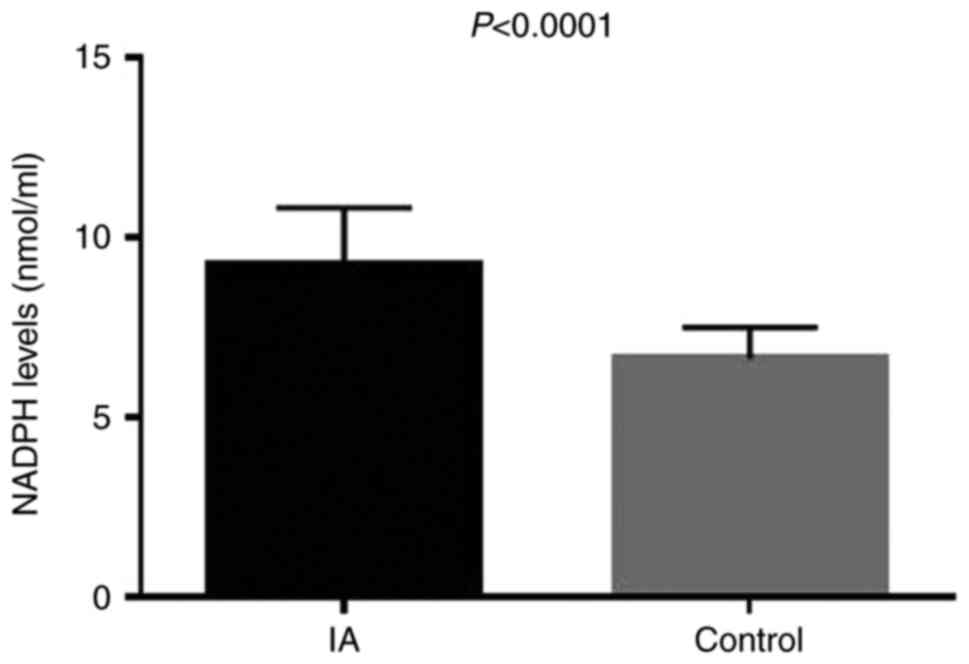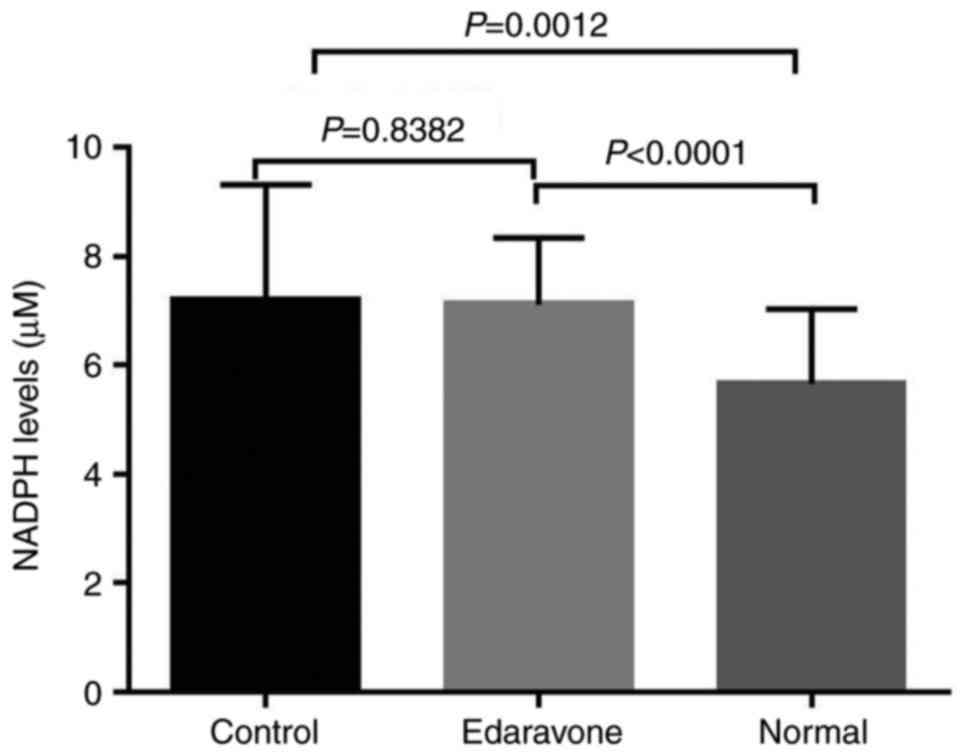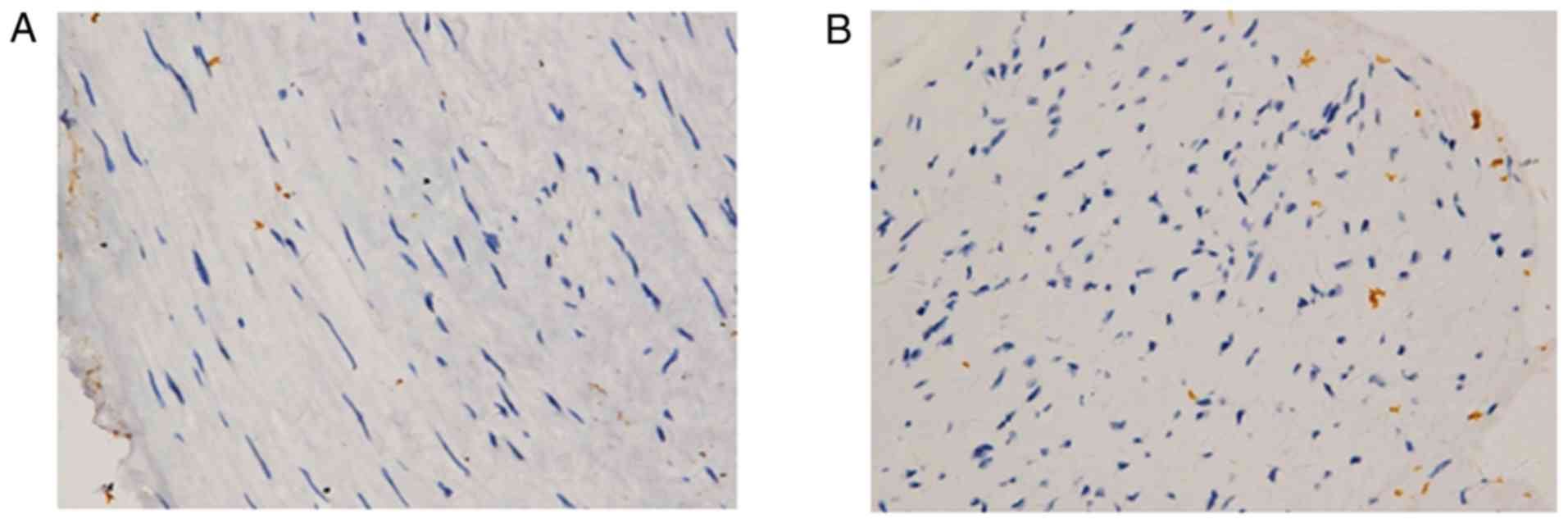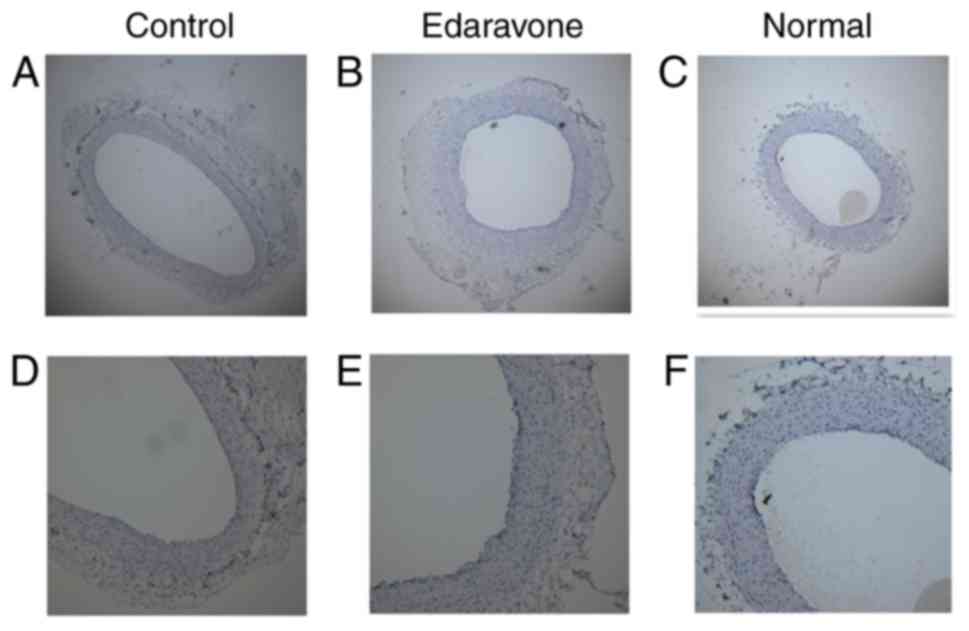|
1
|
Etminan N and Macdonald RL: Management of
aneurysmal subarachnoid hemorrhage. Handb Clin Neurol. 140:195–228.
2017. View Article : Google Scholar : PubMed/NCBI
|
|
2
|
Safavi-Abbasi S, Kalani MYS, Frock B, Sun
H, Yagmurlu K, Moron F, Snyder LA, Hlubek RJ, Zabramski JM, Nakaji
P and Spetzler RF: Techniques and outcomes of microsurgical
management of ruptured and unruptured fusiform cerebral aneurysms.
J Neurosurg. 127:1353–1360. 2017. View Article : Google Scholar : PubMed/NCBI
|
|
3
|
Safavi-Abbasi S, Moron F, Sun H, Wilson C,
Frock B, Oppenlander ME, Xu DS, Ghafil C, Zabramski JM, Spetzler RF
and Nakaji P: Techniques and outcomes of Goretex Clip-wrapping of
ruptured and unruptured cerebral aneurysms. World Neurosurgery.
90:281–290. 2016. View Article : Google Scholar
|
|
4
|
Ganesh Kumar N, Ladner TR, Kahn IS,
Zuckerman SL, Baker CB, Skaletsky M, Cushing D, Sanborn MR, Mocco J
and Ecker RD: Parent vessel occlusion for treatment of cerebral
aneurysms: Is there still an indication? A series of 17 patients. J
Neurol Sci. 372:250–255. 2017. View Article : Google Scholar
|
|
5
|
Lawton MT, Abla AA, Rutledge WC, Benet A,
Zador Z, Rayz VL, Saloner D and Halbach VV: Bypass surgery for the
treatment of dolichoectatic basilar trunk aneurysms: A work in
progress. Neurosurgery. 79:83–99. 2016. View Article : Google Scholar :
|
|
6
|
Lee K, Park H, Park I, Park SQ, Kwon OK
and Han J: Y-configuration Stent-assisted Coil Embolization for
Wide-necked intracranial bifurcation aneurysms. J Cerebrovasc
Endovasc Neurosurg. 18:355–362. 2016. View Article : Google Scholar
|
|
7
|
Tan J, Ndoro S, Okafo U, Garrahy A, Agha A
and Rawluk D: Delayed recovery of adipsic diabetes insipidus (ADI)
caused by elective clipping of anterior communicating artery and
left middle cerebral artery aneurysms. N Z Med J. 129:86–90.
2016.PubMed/NCBI
|
|
8
|
Imaizumi S, Woolworth V, Fishman RA and
Chan PH: Liposome-entrapped superoxide dismutase reduces cerebral
infarction in cerebral ischemia in rats. Stroke. 21:1312–1317.
1990. View Article : Google Scholar : PubMed/NCBI
|
|
9
|
del Zoppo GJ, Schmid-Schonbein GW, Mori E,
Copeland BR and Chang CM: Polymorphonuclear leukocytes occlude
capillaries following middle cerebral artery occlusion and
reperfusion in baboons. Stroke. 22:1276–1283. 1991. View Article : Google Scholar : PubMed/NCBI
|
|
10
|
Walder CE, Green SP, Darbonne WC, Mathias
J, Rae J, Dinauer MC, Curnutte JT and Thomas GR: Ischemic stroke
injury is reduced in mice lacking a functional NADPH oxidase.
Stroke. 28:2252–2258. 1997. View Article : Google Scholar : PubMed/NCBI
|
|
11
|
Dinauer MC: The respiratory burst oxidase
and the molecular genetics of chronic granulomatous disease. Crit
Rev Clin Lab Sci. 30:329–369. 1993. View Article : Google Scholar : PubMed/NCBI
|
|
12
|
Ushio-Fukai M, Zafari AM, Fukui T,
Ishizaka N and Griendling KK: p22phox is a critical component of
the superoxide-generating NADH/NADPH oxidase system and regulates
angiotensin II-induced hypertrophy in vascular smooth muscle cells.
J Biol Chem. 271:23317–23321. 1996. View Article : Google Scholar : PubMed/NCBI
|
|
13
|
Tada Y, Kitazato KT, Tamura T, Yagi K,
Shimada K, Kinouchi T, Satomi J and Nagahiro S: Role of
mineralocorticoid receptor on experimental cerebral aneurysms in
rats. Hypertension. 54:552–557. 2009. View Article : Google Scholar : PubMed/NCBI
|
|
14
|
Griendling KK, Minieri CA, Ollerenshaw JD
and Alexander RW: Angiotensin II stimulates NADH and NADPH oxidase
activity in cultured vascular smooth muscle cells. Circ Res.
74:1141–1148. 1994. View Article : Google Scholar : PubMed/NCBI
|
|
15
|
Cahilly C, Ballantyne CM, Lim DS, Gotto A
and Marian AJ: A variant of p22(phox), involved in generation of
reactive oxygen species in the vessel wall, is associated with
progression of coronary atherosclerosis. Circ Res. 86:391–395.
2000. View Article : Google Scholar : PubMed/NCBI
|
|
16
|
Ito D, Murata M, Watanabe K, Yoshida T,
Saito I, Tanahashi N and Fukuuchi Y: C242T polymorphism of NADPH
oxidase p22 PHOX gene and ischemic cerebrovascular disease in the
Japanese population. Stroke. 31:936–939. 2000. View Article : Google Scholar
|
|
17
|
Xia Y, Xia H, Chen D, Liao Z and Yan Y:
Mechanisms of autophagy and apoptosis mediated by JAK2 signaling
pathway after spinal cord injury of rats. Exp Ther Med.
14:1589–1593. 2017. View Article : Google Scholar : PubMed/NCBI
|
|
18
|
Belsley SJ and Tilson MD: Two decades of
research on etiology and genetic factors in the abdominal aortic
aneurysm (AAA)-with a glimpse into the 21st century. Acta Chir
Belg. 103:187–196. 2003. View Article : Google Scholar : PubMed/NCBI
|
|
19
|
Absi TS, Sundt TM III, Tung WS, Moon M,
Lee JK, Damiano RR Jr and Thompson RW: Altered patterns of gene
expression distinguishing ascending aortic aneurysms from abdominal
aortic aneurysms: Complementary DNA expression profiling in the
molecular characterization of aortic disease. J Thorac Cardiovasc
Surg. 126:344–357. 2003. View Article : Google Scholar : PubMed/NCBI
|
|
20
|
Pincemail J, Defraigne JO, Cheramy-Bien
JP, Dardenne N, Donneau AF, Albert A, Labropoulos N and Sakalihasan
N: On the potential increase of the oxidative stress status in
patients with abdominal aortic aneurysm. Redox Rep. 17:139–144.
2012. View Article : Google Scholar : PubMed/NCBI
|
|
21
|
Gavrila D, Li WG, McCormick ML, Thomas M,
Daugherty A, Cassis LA, Miller FJ Jr, Oberley LW, Dellsperger KC
and Weintraub NL: Vitamin E inhibits abdominal aortic aneurysm
formation in angiotensin II-infused apolipoprotein E-deficient
mice. Arterioscler Thromb Vasc Biol. 25:1671–1677. 2005. View Article : Google Scholar : PubMed/NCBI
|
|
22
|
Xiong W, Mactaggart J, Knispel R, Worth J,
Zhu Z, Li Y, Sun Y, Baxter BT and Johanning J: Inhibition of
reactive oxygen species attenuates aneurysm formation in a murine
model. Atherosclerosis. 202:128–134. 2009. View Article : Google Scholar :
|
|
23
|
Marzatico F, Gaetani P, Tartara F,
Bertorelli L, Feletti F, Adinolfi D, Tancioni F and Rodriguez y
Baena R: Antioxidant status and alpha1-antiproteinase activity in
subarachnoid hemorrhage patients. Life Sci. 63:821–826. 1998.
View Article : Google Scholar : PubMed/NCBI
|
|
24
|
Takagi H and Umemoto T; lice
(All-Literature Investigation of Cardiovascular Evidence) group:
Vitamins and abdominal aortic aneurysm. Int Angiol. 36:21–30.
2017.
|
|
25
|
Aoki T, Nishimura M, Kataoka H, Ishibashi
R, Nozaki K and Hashimoto N: Reactive oxygen species modulate
growth of cerebral aneurysms: A study using the free radical
scavenger edaravone and p47phox(−/−) mice. Lab Invest. 89:730–741.
2009. View Article : Google Scholar : PubMed/NCBI
|
|
26
|
Longo GM, Xiong W, Greiner TC, Zhao Y,
Fiotti N and Baxter BT: Matrix metalloproteinases 2 and 9 work in
concert to produce aortic aneurysms. J Clin Invest. 110:625–632.
2002. View Article : Google Scholar : PubMed/NCBI
|
|
27
|
Park WH: Exogenous
H2O2 induces growth inhibition and cell death
of human pulmonary artery smooth muscle cells via glutathione
depletion. Mol Med Rep. 14:936–942. 2016. View Article : Google Scholar : PubMed/NCBI
|
|
28
|
Morimoto K, Hasegawa T, Tanaka A, Wulan B,
Yu J, Morimoto N, Okita Y and Okada K: Free-radical scavenger
edaravone inhibits both formation and development of abdominal
aortic aneurysm in rats. J Vasc Surg. 55:1749–1758. 2012.
View Article : Google Scholar : PubMed/NCBI
|
|
29
|
Hu J, Luo J, Wang H, Wang C, Sun X, Li A,
Zhou Y, Liu Y and Chen Q: Association of TNF-α-3959T/C Gene
polymorphisms in the Chinese population with intracranial
aneurysms. J Mol Neurosci. 63:349–354. 2017. View Article : Google Scholar : PubMed/NCBI
|
|
30
|
Meijles DN, Fan LM, Ghazaly MM, Howlin B,
Krönke M, Brooks G and Li JM: p22phox C242T Single-nucleotide
polymorphism inhibits inflammatory oxidative damage to endothelial
cells and vessels. Circulation. 133:2391–2403. 2016. View Article : Google Scholar : PubMed/NCBI
|
|
31
|
Najafi M, Alipoor B, Shabani M,
Amirfarhangi A and Ghasemi H: Association between rs4673 (C/T) and
rs13306294 (A/G) haplotypes of NAD(P)H oxidase p22phox gene and
severity of stenosis in coronary arteries. Gene. 499:213–217. 2012.
View Article : Google Scholar : PubMed/NCBI
|
|
32
|
Sun J, Wen M, Wang Y, Liu D, Ying W and
Wang X: The three CYBA variants (rs4673, rs1049254 and rs1049255)
are benign: New evidence from a patient with CGD. BMC Med Genet.
18:1272017. View Article : Google Scholar : PubMed/NCBI
|
|
33
|
Watanabe S, Nitta N, Sonoda A, Nitta-Seko
A, Ohta S, Tsuchiya K, Otani H, Tomozawa Y, Nagatani Y, Mukaisho K,
et al: Inhibition of fibrosis and inflammation by triple therapy
with pirfenidone, edaravone and erythropoietin in rabbits with
drug-induced lung injury: Comparison of CT imaging and pathological
findings. Exp Ther Med. 6:1096–1100. 2013. View Article : Google Scholar : PubMed/NCBI
|
|
34
|
Wang Y, Ma C, Xu N, Xu K, Wang H, Yu J, Li
Y, Wang K, Wang X and Luo Q: An improved elastase-based method to
create a saccular aneurysm rabbit model. Br J Neurosurg.
27:779–782. 2013. View Article : Google Scholar : PubMed/NCBI
|
|
35
|
Jiang ZZ, Liu XT, Ma CY, He C, Li XY, Hou
CL, Cheng ZS and Xia GY: Detection of atherosclerotic plaques in
the rabbit aorta using ultrasound microbubbles conjugated to
interleukin-18 antibodies. Med Sci Monit. 23:5446–5454. 2017.
View Article : Google Scholar : PubMed/NCBI
|
|
36
|
Rao J, Brown BN, Weinbaum JS, Ofstun EL,
Makaroun MS, Humphrey JD and Vorp DA: Distinct macrophage phenotype
and collagen organization within the intraluminal thrombus of
abdominal aortic aneurysm. J Vasc Surg. 62:585–593. 2015.
View Article : Google Scholar : PubMed/NCBI
|
|
37
|
Van Spyk EN, Chun KC, Samadzadeh KM,
Peters JH and Lee ES: Increased levels of CD34+ cells
are associated in patients with abdominal aortic aneurysms compared
with patients with peripheral vascular disease. J Surg Res.
184:638–643. 2013. View Article : Google Scholar : PubMed/NCBI
|
|
38
|
Liang C, Feng H, Deng BQ, Li ZF, Huang QH,
Zhao W, Zhao WY, Yang PF, Xu Y, Zhao R and Liu JM: Decreased levels
and function of circulating endothelial progenitor cells in
unruptured intracranial saccular aneurysm patients. Neurol Sci.
35:23–28. 2014. View Article : Google Scholar
|
|
39
|
Lewis DA, Ding YH, Dai D, Kadirvel R,
Danielson MA, Cloft HJ and Kallmes DF: Morbidity and mortality
associated with creation of elastase-induced saccular aneurysms in
a rabbit model. AJNR Am J Neuroradiol. 30:91–94. 2009. View Article : Google Scholar :
|
|
40
|
Pyo R, Lee JK, Shipley JM, Curci JA, Mao
D, Ziporin SJ, Ennis TL, Shapiro SD, Senior RM and Thompson RW:
Targeted gene disruption of matrix metalloproteinase-9 (gelatinase
B) suppresses development of experimental abdominal aortic
aneurysms. J Clin Invest. 105:1641–1649. 2000. View Article : Google Scholar : PubMed/NCBI
|
|
41
|
Yang X, Li J, Fang Y, Zhang Z, Jin D, Chen
X, Zhao Y, Li M, Huan L, Kent TA, et al: Rho guanine nucleotide
exchange factor ARHGEF17 Is a risk gene for intracranial aneurysms.
Circ Genom Precis Med. 11:e0020992018.
|
|
42
|
Yamada Y, Kato K, Oguri M, Horibe H,
Fujimaki T, Yasukochi Y, Takeuchi I and Sakuma J: Identification of
nine genes as novel susceptibility loci for early-onset ischemic
stroke, intracerebral hemorrhage, or subarachnoid hemorrhage.
Biomed Rep. 9:8–20. 2018.PubMed/NCBI
|
|
43
|
van Donkelaar CE, Potgieser ARE, Groen H,
Foumani M, Abdulrahman H, Sluijter R, van Dijk JMC and Groen RJM:
Atmospheric pressure variation is a delayed trigger for aneurysmal
subarachnoid hemorrhage. World Neurosurg. 112:e783–e790. 2018.
View Article : Google Scholar
|
|
44
|
Patrice T, Rozec B, Desal H and Blanloeil
Y: Oceanic meteorological conditions influence incidence of
aneurysmal subarachnoid hemorrhage. J Stroke Cerebrovasc Dis.
26:1573–1581. 2017. View Article : Google Scholar : PubMed/NCBI
|
|
45
|
Fontanella M, Rainero I, Gallone S, Rubino
E, Fenoglio P, Valfre W, Garbossa D, Carlino C, Ducati A and
Pinessi L: Tumor necrosis factor-alpha gene and cerebral aneurysms.
Neurosurgery. 60:668–673. 2007. View Article : Google Scholar : PubMed/NCBI
|
|
46
|
Zhang G, Tu Y, Feng W, Huang L, Li M and
Qi S: Association of interleukin-6-572G/C gene polymorphisms in the
Cantonese population with intracranial aneurysms. J Neurol Sci.
306:94–97. 2011. View Article : Google Scholar : PubMed/NCBI
|
|
47
|
Li LJ, Pan XM, Sima X, Li ZH, Zhang LS,
Sun H, Zhu Y, Liang WB, Gao LB and Zhang L: Interactions of
interleukin-12A and interleukin-12B polymorphisms on the risk of
intracranial aneurysm. Mol Biol Rep. 39:11217–11223. 2012.
View Article : Google Scholar : PubMed/NCBI
|
|
48
|
Sutliff RL, Hilenski LL, Amanso AM,
Parastatidis I, Dikalova AE, Hansen L, Datla SR, Long JS, El-Ali
AM, Joseph G, et al: Polymerase delta interacting protein 2
sustains vascular structure and function. Arterioscler Thromb Vasc
Biol. 33:2154–2161. 2013. View Article : Google Scholar : PubMed/NCBI
|
|
49
|
Tamura T, Jamous MA, Kitazato KT, Yagi K,
Tada Y, Uno M and Nagahiro S: Endothelial damage due to impaired
nitric oxide bioavailability triggers cerebral aneurysm formation
in female rats. J Hypertens. 27:1284–1292. 2009. View Article : Google Scholar : PubMed/NCBI
|
|
50
|
Krex D, Ziegler A, Konig IR, Schackert HK
and Schackert G: Polymorphisms of the NADPH oxidase P22PHOX gene in
a Caucasian population with intracranial aneurysms. Cerebrovasc
Dis. 16:363–368. 2003. View Article : Google Scholar : PubMed/NCBI
|
|
51
|
Dalman RL: Oxidative stress and abdominal
aneurysms: How aortic hemodynamic conditions may influence AAA
disease. Cardiovasc Surg. 11:417–419. 2003. View Article : Google Scholar : PubMed/NCBI
|
|
52
|
Pincemail J, Defraigne JO, Courtois A,
Albert A, Cheramy-Bien JP and Sakalihasan N: Abdominal aorta
aneurysm (AAA): Is there a role for prevention and therapy using
antioxidants? Curr Drug Targets. Sep 18–2017.Epub ahead of
print.
|
|
53
|
Yoshimura K, Aoki H, Ikeda Y, Furutani A,
Hamano K and Matsuzaki M: Regression of abdominal aortic aneurysm
by inhibition of c-Jun N-terminal kinase in mice. Ann NY Acad Sci.
1085:74–81. 2006. View Article : Google Scholar : PubMed/NCBI
|
|
54
|
Tornwall ME, Virtamo J, Haukka JK, Albanes
D and Huttunen JK: Alpha-tocopherol (vitamin E) and beta-carotene
supplementation does not affect the risk for large abdominal aortic
aneurysm in a controlled trial. Atherosclerosis. 157:167–173. 2001.
View Article : Google Scholar : PubMed/NCBI
|
|
55
|
Ollikainen E, Tulamo R, Frösen J, Lehti S,
Honkanen P, Hernesniemi J, Niemela M and Kovanen PT: Mast cells,
neovascularization, and microhemorrhages are associated with
saccular intracranial artery aneurysm wall remodeling. J
Neuropathol Exp Neurol. 73:855–864. 2014. View Article : Google Scholar : PubMed/NCBI
|
|
56
|
Rodella LF, Rezzani R, Bonomini F, Peroni
M, Cocchi MA, Hirtler L and Bonardelli S: Abdominal aortic aneurysm
and histological, clinical, radiological correlation. Acta
Histochem. 118:256–262. 2016. View Article : Google Scholar : PubMed/NCBI
|


















